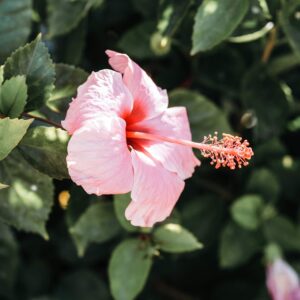Introduction
Soybeans. Palm oils. Rubber. Indigo dyes. Cotton. From ravaging the Amazon rainforest to monocultural cultivation ruining the biodiversity and ecosystem, plants haven’t always had a clean history.
In fact, some plants –for their utility and practical usage– have endured a history of environmental catastrophe and bloodshed. We have the soybean industry to thank for much of the Amazon rainforest’s destruction. Indigo plantations led to the degradation of morality, as slavery was legalized to keep the indigo industry alive in the state of Georgia.
But, with all these metaphorical guns germs, and steel surrounding the world of plants, there’s one with a fascinating history that goes mostly unnoticed by the general public. And, it’s one we here at Aimstemgirls have wanted to share with our fellow Stem girl viewers here who have a streak of green thumb: the history of Hawaiian Sandalwood.
And, hey: if you’re not too much a fan of botanical “stuff,” don’t worry. This is going to be an interesting one.
So, get comfortable. Cozy on up. Get a snack or something.
This will be good.
Table of Contents:
- Historical Decline of Hawaiian Sandalwood
- Impact of Sandalwood Trade
- Conservation efforts and Reforestation
- Cultural Significance of Sandalwood in Hawaii
- Challenges in Sandalwood Restoration
- Role of Indigenous Knowledge in Sandalwood Conservation
- Potential Economic Revival
Historical Decline of Hawaiian Sandalwood
The story of the Hawaiian Sandalwood, scientifically known as Santalum ellipticum) is rife with tragedy.
It’s a medley of historical exploitation and environmental consequences. This iconic tree, known for its aromatic heartwood, faced dramatic decline during the 19th century due to extensive logging driven by global demand.
The sandalwood which played a significant role in Hawaii’s economic history, led to the depletion of once-thriving sandalwood forests across the islands. This exploitation not only reshaped the landscape but also disrupted the delicate ecological balance. This unnatural interference with the natural order of the ecosystem left a profound impact that didn’t just negatively impact the environment. It also left a massive impact on the culture surrounding Hawaiian sandalwood.
Its historical decline stands as an important chapter in the islands’ environmental history. Unfortunately, what happened to Hawaiian sandalwood is just one of many instances certain plants lead to environmental and cultural disasters. It also serves as a testament to the dangers of supplying modern consumerist demands.
The 19th century saw Hawaiian sandalwood face widespread exploitation. From an economic standpoint, the sandalwood’s fragrant heartwood escalated demand. This demand was satisfied by European and American merchants, leading to the depletion of sandalwood forests across the Hawaiian Islands. This aromatic wood’s aromatic charms spanned far beyond the Hawaiian Islands, with eager traders from Asia. This marked the beginning of the Hawaiian sandalwood industry. And, vast tracts of native sandalwood trees were cut down in the name of pursuing this industry’s opportunities for profit.
The consequences were extremely profound. The environment would be reshaped completely due to farming practices. And, the triggered ecological imbalance led to disruptions in surrounding flora and plants. The historical decline of Hawaiian sandalwood highlights the fragility of the ecosystem when faced with exploitation and thus underscores the importance of sustainable resource management when preserving the biodiversity of native species.
When considering ecological disasters and environmental injustices, trade, and economic principles cannot be ignored. For, it is often for the very reasons of profit and human gain that most catastrophic ecological damage ensues.
The sandalwood trade was a significant chapter in the economic history of various regions and has been characterized by a complex interplay of commerce, cultural exchange, and environmental impact.
Historically, India served as a key player in the sandalwood trade. The fragrant wood was used in religious ceremonies, perfumes, and traditional medicine. In the 19th century, the demand for sandalwood extended beyond the Hawaiian Islands, where traders sought the valuable heartwood of Hawaiian sandalwood. The sandalwood trade in Hawaii had profound consequences, leading to the overexploitation and depletion of sandalwood forests.
How?
Well, the relationship between customers and merchants of sandalwood can be simply understood as supply and demand. Merchants have a supply (sandalwood) and customers have a demand (fragrant woods like sandalwood.) Money is exchanged. But, it gets more complicated when the demand for sandalwood goes up as the product’s good reputation starts to spread. More people will want the product; and, to accommodate for said desire, merchants must increase their supply. Increased supply meets increased demand. This principle works in general across multiple dimensions of plant products.
Additionally, Hawaiian sandalwood like other in-demand plants or cash crops would endure positive feedback loops. That is, the market raises demand for sandalwood while merchants persist in meeting each demand. Not curbing the demand and always giving in to said demand essentially incentivizes the market to balloon in demand without any opposing forces. This leads to a neverending stream of producing more and more sandalwood even if it means ravaging native lands –all for the sake of meeting customer demand.
As merchants responded to markets in Asia, the Hawaiian sandalwood trade would come to shape both economic and cultural landscapes; It also forged cultural connections between regions. Today, discussions surrounding the sustainable and ethical aspects of the sandalwood trade continue, emphasizing the need for responsible harvesting practices and conservation efforts to ensure the long-term viability of these culturally significant and economically valuable trees.
Conservation Efforts and Reforestation
It’s not like it’s all gloom and doom, though.
Contemporary conservation efforts have responded to the historical depletion of Hawaiian sandalwood. Reforestation is now playing a pivotal role in rejuvenating the Hawaiian sandalwood. Organizations, government agencies, and local communities have also joined forces to address the ecological repercussions of overharvesting and habitat degradation.
Some reforestation projects include planting sandalwood saplings in their native habitats. This helps in restoring balance to an otherwise monocultural ecosystem. These efforts aim not only to bring back the iconic sandalwood tree but also to protect the diverse flora and fauna that rely on these unique habitats.
However, it’s not always about having a bleeding heart for the trees. Scientific development and STEM logic help in the path toward proper sandalwood conservation. For instance, advanced techniques include studies and applications of genetic diversity to enhance the resilience and survivability of newly reintroduced sandalwood populations. By combining traditional wisdom with scientific innovation, these initiatives strive to create a sustainable future for Hawaiian sandalwood.
Note, though, fellow aspiring STEM ladies, that proper conservation efforts of the Hawaiian sandalwood follow the same pattern across time. Conservation efforts are not taken seriously or executed to the degree they should until it’s far too late into the game. If you’re looking to make a difference in the world, remember that preventative measures are superior to solving the problem the moment it arrives. Part of the problem with modern conservation is our lack of foresight; for, if we had taken action much earlier, our conservation efforts would be in a much better position!
Cultural Significance of Sandalwood in Hawaii
Culturally, sandalwood in Hawaii played a massive role in weaving the islands’ heritage and traditions.
Historically, it was used in the construction of tools, ornaments, and religious objects, symbolizing both practical utility and spiritual reverence. The sweet and enduring scent made it a crucial element in rituals and ceremonies. In mythology, sandalwood is associated with deities and ancestral spirits. It was also viewed as a symbol of honor, respect, and celebration.
Beyond utilitarian and tangible applications, the cultural importance of sandalwood fosters a connection between humanity and nature.
Unfortunately, the exploitation of sandalwood during the 19th century had profound consequences on its cultural significance. The depletion of sandalwood forests disrupted traditional practices. In contemporary times, efforts to restore and conserve Hawaiian sandalwood are not just ecological but also aim to revive its cultural importance. As the trees are reintroduced to their native habitats, there is a hope of rekindling the cultural practices and spiritual connections associated with this iconic tree, ensuring that the scent of sandalwood remains an integral part of Hawaii’s cultural history.
With the deforestation crisis of Hawaiian sandalwood and continued efforts to restore its population, we can see how the disruption of the ecosystem could have catastrophic rippling effects. In this case, the depletion of sandalwood would also mean the loss of significant cultural identity and symbolic importance that make up major parts of religion, tradition, rituals, mythology, and even deep patterns of cultural archetypes. So, the loss of valuable plants can also have metaphysical impacts outside the measurements of just profit and utility alone.
This is exactly why it’s so important for activists today to be proactive and on their toes about modern small problems. For, if the smaller problems grow larger, they’ll have rippling effects that impact other elements outside of the scope of estimated damage.
Challenges in Sandalwood Restoration
Despite ongoing efforts in sandalwood restoration in Hawaii, several challenges impede the successful recovery of this culturally significant tree.
For one, invasive species are a challenging hurdle; non-native plants compete for resources and can outcompete newly planted sandalwood saplings. One species we’ve brought to Hawaii is the Miconia: a South American plant that spreads like wildfire, prevents other plants from growing, and promotes erosion. While some invasive species are introduced via ships and accidental releases, a majority of invasive species are introduced by people. Human error is the #1 reason for invasive species.
Now, Hawaii’s unique geographical location –what with it being so distant from everywhere else and its volcanic environment– means that most invasive species were brought upon by people. And, with tourism constituting 21% of the state’s economy, there’s no hope of culling that any time soon.
You may begin to see why true conservation becomes a lot more difficult and complex than just surface-level promotion and activism. To solve even one variable of the problem, one would need to assess the economic impact of limiting human interaction. Additionally, this would infringe on legal and governmental policy problems; thus, the problem of conservation becomes a multidisciplinary problem.
Another challenge is habitat degradation. Altering ecosystems due to human activities, such as agriculture or urban development, has resulted in the loss of suitable habitat for sandalwood. Perhaps one of the most difficult things about habitat degradation is how unforgiving it is. For, there is often no “backspace” button for when we’ve decimated lands. Efforts to restore environments can be not only costly but also very time-expensive and sometimes virtually impossible. For the latter instance, it’s a one-and-done deal. The land is gone. Period. Hence, this is why preventative measures are so crucial: you can spot the problem early and deal with it before it’s absolutely too late.
Moreover, climate change is another hurdle. Changes in temperature, precipitation patterns, and other climate factors can affect the growth and survival of newly planted saplings. And, again, previous variables like human interaction and tourism can play a big role in changing the natural ecosystem and climate. Because much of Hawaii must accommodate tourist attractions and sensibilities, the resources and environment must take a hit to appease these tastes. It’s why so much maintenance is done to keep touristy parts of Hawaii “attractive” and tourist-friendly. One such example of this principle in action includes the impact on coral reefs. The commodification of Hawaiian environments and plants such as sandalwood have had massive negative impacts on its survivability.
Additionally, ensuring genetic diversity within restored populations is a critical concern. Limited genetic diversity can make the trees more susceptible to diseases and environmental stress. Conservationists and researchers are working to incorporate genetic studies into restoration plans to enhance the overall health and adaptability of sandalwood populations.
Role of Indigenous Knowledge in Sandalwood Conservation
If there’s one way to conceptualize conservation efforts of Hawaiian sandalwood, it’s like spinning plates. Except, there are a million plates and once one break, it breaks your concentration which makes more plates break –so on and so forth. In the world of conservation, we see the same. One problem is actually rooted in more problems, which can be solved without first addressing a pluripotential network of many more. Economic problems are related to cultural problems, which get mixed in with political problems, and then get tangled with legal problems.
Yeah. If you’re still enjoying your popcorn, then great. Let’s take a break from the falling plates and see some positivity.
Indigenous knowledge encompasses the traditional wisdom, practices, and insights of Native Hawaiian communities, passed down through generations. In the context of sandalwood conservation, this knowledge contributes to a nuanced understanding of the tree’s ecology, cultural significance, and the intricate relationships between sandalwood and the broader environment. Indigenous knowledge guides conservationists in identifying culturally significant sites and areas of ecological importance for sandalwood. It offers insights into traditional planting methods, the timing of ceremonies, and the integration of cultural practices into conservation efforts. By acknowledging and incorporating this indigenous wisdom, conservation initiatives align with the values and beliefs of the local communities. Furthermore, indigenous knowledge contributes to the identification of sustainable harvesting practices. Traditional methods of utilizing sandalwood usually do not cause long-term harm to the trees or their ecosystems.
Interestingly enough, following indigenous practices of treating Hawaiian sandalwood might just kill two birds with one stone. As the cultural significance of sandalwood becomes compromised as its populations decrease, increasing it through a revival of traditional indigenous practices may just breathe life into an otherwise atrophying culture.
This is one of the few instances when the solution can be significantly beneficial not just in helping in one dimension, but in multiple. The revivification of tradition and applied indigenous knowledge may set a precedent for future conservationists to take old knowledge more seriously. And, it may set and incentive to value the wisdom that comes from the past, ensuring we don’t repeat the same mistakes in the future.
Potential Economic Revival
As conservation efforts aim to restore sandalwood populations to their historical abundance, there is an opportunity for a regulated and ethical sandalwood industry to emerge.
Sandalwood has a rich history of economic importance in Hawaii, and a revived industry could contribute to local economies and job creation. Sustainable harvesting practices, informed by indigenous knowledge and modern conservation principles, could support a steady supply of sandalwood while ensuring the long-term health of the trees and their ecosystems. Local businesses, guided by traditional knowledge and values, could engage in the sustainable harvest of sandalwood, creating products that honor the cultural significance of the tree. This might include the production of traditional crafts, ceremonial items, or sustainable sandalwood-based products for local and global markets.
However, the economic revival must be approached with caution and a commitment to balance economic interests with ecological sustainability and cultural preservation. Strict regulations and monitoring systems would be necessary to prevent overharvesting and ensure that economic activities align with the principles of responsible resource management.
Remember what we mentioned in the past. Often, when demand increases, supply must follow suit to appease the former’s needs. It’s the forces of the market at work. So, this can make a good argument for more heavy-handed regulation of a growing industry if it means protecting the sanctity of Hawaiian sandalwood.
Ultimately, we’ve seen how the conservation of certain plants cannot be discussed without the multi-variable perspectives surrounding it. Colonial predictions, economic structures, cultural significance, and environmental disasters all play a significant role in how we approach conservation. And, the Hawaiian sandalwood is but one of many plants that have endured a history rich with both good and bad.












